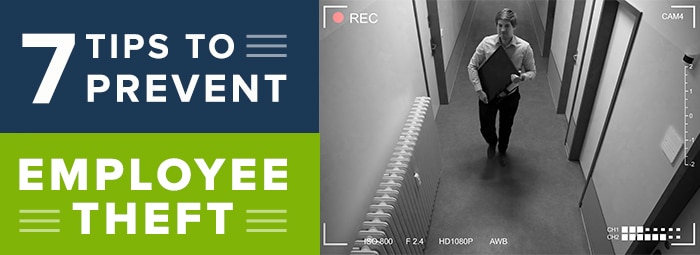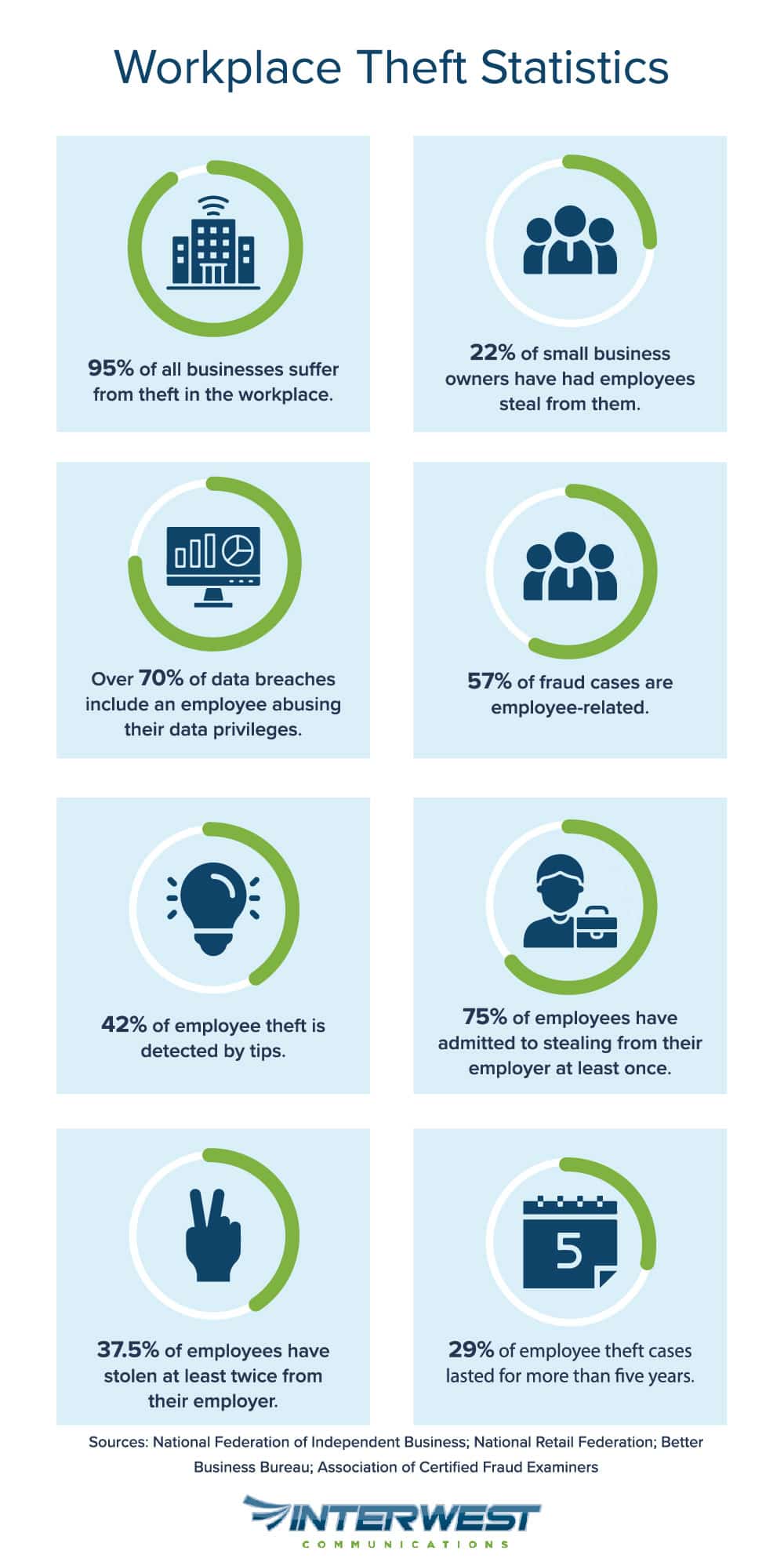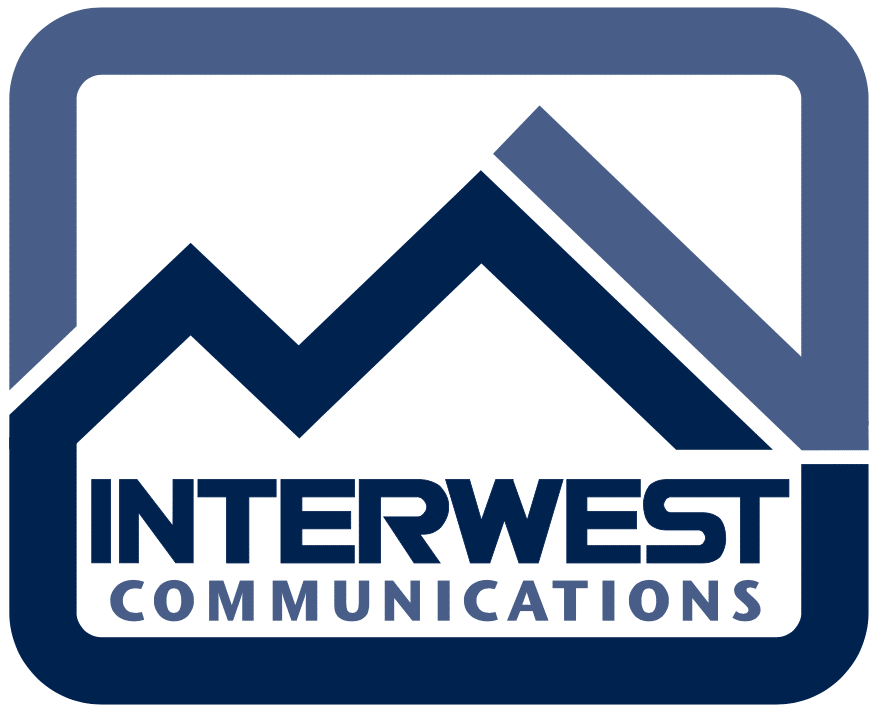- April 29, 2025
- Posted by: Interwest Communications Team
- Categories: News, Uncategorized

Originally posted on August 31, 2022 @ 10:14 pm
How to Prevent Employee Theft: 7 Need to Know Tips
Besides common security threats such as cyberattacks, burglary, and shoplifting, you shouldn’t overlook potential internal crimes perpetrated by employees. According to a recent report by the National Federation of Independent Business (NFIB), employees are 15 times more likely to steal from a business than non-employees.
The financial damage resulting from such criminal activity can be devastating, with the National Retail Federation highlighting that internal theft costs retailers an average of $1,551.66 per incident of employee theft. Small businesses face the highest risk and may not fully recover from the consequences of employee fraud and theft. For this reason, it’s best to learn about the types of employee theft and how to prevent employee theft.

5 Types of Employee Theft
The definition of employee theft is taking or misusing an employer’s belongings without their permission. It extends to other valuables such as data or time. The following are the most common.
- Merchandise theft: Classified as theft of any product for sale to customers. Retailers experience such theft more often.
- Theft of supplies: Taking items such as notebooks and scissors for personal use. In restaurants, silverware and plates are the most commonly stolen items.
- Time theft: Occurs when workers are not doing work during work hours, or they tamper with the time track data and get paid those hours. This is a common concern for employers with the rise of remote work.
- Money theft: Occurs whenever a worker pockets money from the cash register or engages in fraud or embezzlement.
- Data theft: Involves stealing or sharing sensitive business information. Formulas, banking information, designs, client lists, and many more could bring a business to its knees if they fall into the wrong hands.
Multiple forms of theft can be a breach in both physical security and network security, which is why it’s important to address security on multiple levels, as well as internally.
Why Do Employees Engage in Theft?
The first step to preventing employee theft is knowing the reasoning behind the crime. The motives for stealing may be greed, unexpected financial obligations, and to satisfy their addictions, among others. When an opportunity presents itself in the form of weak controls and processes in the workplace, a worker internally convinces themselves and commits the theft.
Some of the actions you can take to prevent motive for employee theft include:
- Ensure fair and competitive pay. Pay sick days and on time to avoid employees becoming disgruntled.
- Regularly checking in with workers will alert you of warning signs such as emergency financial burdens happening to their lives. You can then help find a solution before the situation escalates to theft.
- Offering therapy and counseling to the workers will go a long way in curbing the vice. Problems such as addiction, illness/death in the family, or a partner’s job loss may lead anyone to mental stress.
7 Tips to Help Prevent Employee Theft
In addition to understanding the motives of employee theft, another important step in preventing it is to prevent the opportunity for theft. Below are some of the preventative measures for employee theft:
1. Use Access Control Systems
Establishing an access control system can help you keep track of entry and exit times at your business premises. It allows you to maintain detailed security logs of your employees’ movement throughout the day. It is also easy to restrict and change access to sensitive areas. Since the system stores the data, you can evaluate and notice trends.
For instance, if your stockroom is protected by an entry device, the system will log the entry and departure whenever employees swipe their card or enter their code. If it’s detected that $1,000 worth of company merchandise got stolen from the storeroom, you can check the entry and exit logs to establish who was there when the theft occurred. Knowing who was on the premises when the theft occurred provides potential leads about the crime. Access control also helps to deter potential employee theft just knowing it’s there.
2. Use Video Surveillance
Installing a multi-camera video surveillance system is another effective strategy to deter employee theft. Ideally, the cameras should get installed in an area with the most vulnerable assets. Your employees are less likely to steal or act dishonestly if they know they’re under watch. In a retail store, surveillance cameras at the point of sale deter both employee and customer theft.
Surveillance cameras installed where your employees check-in may also be helpful in preventing payroll fraud. If you get suspicious of employees’ hours log, you only need to review the surveillance footage to check whether they are honest about their working hours.
3. Create Anti-theft Policies
Deterring workplace theft starts by telling your employees about it and setting clear boundaries regarding company property. Unfortunately, few businesses have an antitheft policy and assume that employees will do the right thing. For this reason, you should inform your employees about what you expect of them and implement procedures for ascertaining that everything gets done right.
Write clear policies to deter theft in the workplace and communicate the same to the employees. The policies must provide a list of intolerable behaviors and outline their consequences. Without an anti-theft policy, employees won’t have anything to stop them from stealing company property and funds. Some of the anti-theft policies you may want to establish include:
- Establishing written rules outlining the procedures for handling company cash, inventory, supplies, and equipment.
- Outlining employees’ access to assets such as cash drawers and safes and having a confidential reporting system so that they can report violations.
- Undertaking regular employee screening to deter theft.
- Informing employees about updates to the anti theft policy and taking disciplinary action against those who go against it.
- A policy on employees not serving friends or relatives may prevent the temptation to give away items for free.
Additional Policies to prevent employee theft include:
- Stricter hiring process – Background checks are not as expensive as they used to be. Screen employees before hiring to ensure they do not have a criminal record. Call references as some crimes may go unreported.
- Encourage employees to report theft – When fraudsters and thieves think other workers may report them, they are less likely to steal. Offering a reward will encourage others to report suspicious behavior. Have a system in place like a hotline to anonymously give information without fear.
- Use checks and balances – Checks and balances ensure you detect and deter theft before it occurs. For instance, limit the amount a cashier can refund and require a manager to do it if it exceeds.
4. Practice Proper Bookkeeping
Poor bookkeeping is among the things that motivate employees to steal, knowing too well they won’t get detected. Theft of money, in particular, starts when a single employee controls a significant chunk of financial transactions. For this reason, administrative duties such as purchases, reimbursements, payroll, and other cash-related disbursements should get assigned to different employees. Likewise, they should be reviewed and signed off by senior employees.
Bank reconciliations and reviews should be performed regularly, and record books maintained properly. Each transaction undertaken by your employees should also get recorded. In doing so, you’ll establish an audit trail for pinpointing suspicious activity. It will also be easier to identify transactions that defy the norm.
When you post transactions correctly, it’s easier to detect suspicious activity. A qualified accountant ensures books are clean.
Additional steps included in proper bookkeeping include:
- Count-Iin, count-out cash – The first thing you do in the morning and last thing should be to count cash. When transporting money, it should be a two or more persons affair.
- Review all petty cash – Balance the petty cash register weekly and have more than one employee sign off transactions for transparency.
- Monitor retail transactions – Consider implementing a point of sale system (POS) to automate some of the tasks above. Modern point of sale systems are ideal for monitoring employees at the cash register. Some require a passcode or card swipe to ensure workers do not commit fraud. It can be integrated with other systems to increase accountability and remote monitoring.
5. Track Inventory Closely
No business owner likes to imagine that their employees can steal company supplies and merchandise. Nonetheless, inventory theft is a far too common issue in today’s business world. It can occur anywhere in your supply chain, and the only way to prevent it is by having an inventory tracking solution at multiple points in the supply chain.
Inventory tracking can entail using a combination of software, alarm systems, online technology, and hardware devices to monitor each item in your supply chain. For instance, establishing an inventory tracking system that leverages RFID tech can help you know when your items leave the boundaries of your pre-determined “geofence.” In this case, alerts can be sent out when items leave your warehouse without the requisite permission.
6. Actively Participate in the Business
Participate in the day-to-day running of the business especially when it comes to handling customer transactions. This way, you gain insights and can notice inconsistencies.
- Watch and listen – Monitoring ensures you catch theft early or prevent it from happening. Surveillance cameras are a great help but ensure you operate within legal limits when placing them. Encourage anonymous reporting by offering incentives.
- Tune in to employee behavior – By forming a good relationship with the workers, you can notice behavior changes. If you are suspicious, consider having a sit-down with them to find out if there is a problem.
- Conduct audits – Undertake random audits, especially by external accountants. They ensure you catch thieves off-guard. Check cash registers, returned goods, and vendor files.
- Offer Meals and Discounts – Restaurants can reduce food loss by offering meals and discounts to their employees. Offer perks depending on your type of business to boost morale and deter theft.
7. Don’t Ignore Red Flags
There’s no better way to detect and prevent employee theft than tuning in on their behavior. According to a recent ACFE report, 85% of fraudsters display red flags, which you should watch out for.
Paying attention to minor inconsistencies and behavioral changes can help you detect potential theft before it becomes a significant problem. You should be keen and constantly monitor employee behavior to detect theft before it cripples your business. Look for small behavioral changes or unexplainable alterations in company data. Details to look for in workers include:
- Lifestyle mismatch. An employee spends more than they make, for example, on a new sports car.
- Unusually close association with vendor and/or customer.
- Deterioration of mood, focus, productivity, and attendance.
- They prefer to be alone and it is not the norm.
- Suddenly they do not want to go on vacation.
- Opting to work long hours and odd shifts.
- Not taking sick leave and instead coming in to work.
Also, take note of the following inventory and financial discrepancies, especially if they happen when the same employees are involved:
- Missing supplies, tools, and equipment
- Unexplainable inventory shortages
- Inconsistencies in financial records
Interwest Communications for Theft Prevention
30% of businesses fail due to employee theft or embezzlement, according to the Better Business Bureau. Do not wait until you are among the thirty percent. Implement appropriate security measures to ensure your business continues to thrive. This includes network security in addition to physical security..
Interwest is here to help with phone systems, networking, cloud services, and security for businesses in the Tri-Cities area. Contact us for more information on how we can help.
